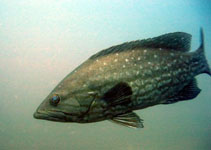| Family: |
Epinephelidae (Groupers) |
| Max. size: |
80 cm TL (male/unsexed); max.weight: 10,000.0 g |
| Environment: |
reef-associated; marine; depth range 3 - 70 m |
| Distribution: |
Western Atlantic: Bermuda and northwestern Gulf of Mexico to Brazil. Report of this species (as Serranus acutirostris) from the Canary Islands is probably a misidentification of Mycteroperca fusca. |
| Diagnosis: |
Dorsal spines (total): 11-11; Dorsal soft rays (total): 15-17; Anal spines: 3-3; Anal soft rays: 10-12. Distinguished by the following characteristics: greyish brown color of head and body with irregular white spots and blotches; 3-4 dark brown stripes radiating posteriorly from the eye and continuing along the ventral half of the body as wavy dark stripes; dark brown stripe from maxillary streak to edge of preopercle; darker median fins with white spots and streaks; oblong and compressed body, depth of body 2.7-3.2 times in SL; head length 2.5-2.7 times in SL; width of maxilla 4.4-5.8% of SL; convex interorbital area; angular preopercle, enlarged serrae at the angle, forming a weak lobe; subequal sizes of anterior and posterior nostrils (Ref. 89707). |
| Biology: |
Maximum depth from Ref. 126840. Juveniles inhabit turtle grass beds, mangrove areas, and shallow waters among soft corals and coral reefs. Adults are found on rocky bottoms with high relief. Probably feeds on plankton (no information is available on the food of this species). The max weight of 4 kg given in Ref. 5222 appears too low. The species is a popular game fish in southern Brazil for both spear fishermen and rod-and-reel anglers. Fish of 4-7 kg are common, with the spear fishing record at 10.1 kg (Capt. Eduardo Baumeier, pers. comm., 2001). |
| IUCN Red List Status: |
Least Concern (LC); Date assessed: 20 November 2016 Ref. (130435)
|
| Threat to humans: |
harmless |
Source and more info: www.fishbase.org. For personal, classroom, and other internal use only. Not for publication.
